If you’re looking to create a harmonious and balanced home environment, the principles of Feng Shui can be an excellent starting point. The ancient Chinese art of Feng Shui is centered around the idea that the spaces we inhabit can have a significant impact on our physical, emotional, and spiritual well-being. One of the fundamental principles of Feng Shui is the use of the five elements: fire, earth, metal, water, and wood.
In this section, we will explore how to use the five elements in Feng Shui to achieve the optimal balance of energy in your home. By incorporating the right colors, materials, and objects associated with each element, you can promote a sense of harmony and positive energy flow in your living space.
Key Takeaways:
- Understanding the five elements theory is essential before incorporating them into your space.
- The five elements in Feng Shui are fire, earth, metal, water, and wood.
- Each element has unique qualities and significance in balancing energy.
- Using the five elements can have transformative effects on your physical and emotional well-being.
- By balancing the elements, you can promote positive energy flow and overall harmony in your home.
Understanding the Five Elements in Feng Shui
Feng Shui is an ancient Chinese practice that seeks to balance energy, or “chi,” within a space to promote optimal well-being and harmony. Central to Feng Shui are the five elements theory: fire, earth, metal, water, and wood. Each of these elements carries a unique quality and energy that can be incorporated into your living space to promote a sense of balance and positive energy flow.
The five elements theory is a cornerstone of traditional Chinese philosophy and medicine. It is believed that these elements interact and impact each other, creating either positive or negative energy. Understanding the qualities and characteristics of each element is essential to creating the desired balance and harmony in your space.
Fire Element
The fire element represents passion, energy, and transformation in Feng Shui. Incorporating the fire element can ignite inspiration and motivation in your space. Suitable placement, colors, and materials associated with the fire element can create a vibrant and lively atmosphere.
Earth Element
The earth element symbolizes stability, nurturing, and grounding in Feng Shui. Incorporating the earth element can promote a sense of security and balance in your home. Suitable objects, colors, and textures that align with the earth element’s energy can create a peaceful and grounding atmosphere.
Metal Element
The metal element signifies clarity, precision, and efficiency in Feng Shui. Incorporating metal objects and colors into your space can promote focus, organization, and productivity. Specific shapes and materials associated with the metal element can create an energetic and stimulating atmosphere.
Water Element
The water element represents flow, abundance, and relaxation in Feng Shui. Incorporating water features, colors, and symbols into your space can create a sense of calmness and tranquility. Appropriate placement and maintenance of water elements can promote positive energy flow and emotional balance.
Wood Element
The wood element symbolizes growth, vitality, and harmony in Feng Shui. Incorporating wood elements, such as plants, furniture, and colors, can promote a sense of renewal and connection with nature. Ideal placement and care for wood elements can create an energizing and uplifting atmosphere.
Understanding the qualities and significance of the five elements in Feng Shui is essential to creating a harmonious and balanced space. By incorporating appropriate elements into your environment, you can promote positive energy flow and enhance your well-being.

Using the Fire Element in Feng Shui
The fire element in Feng Shui represents passion, energy, and transformation. Incorporating the fire element into your space can bring warmth and vibrancy to your home, office, or any other environment.
There are several ways to use the fire element in Feng Shui. One of the most common ways is through the use of the color red. Red is a powerful color that symbolizes love, energy, and vitality. Adding red accents, such as throw pillows, curtains, or artwork, can bring a sense of warmth and energy to any room.
Another way to incorporate the fire element is through the use of candles. Candles can create a beautiful and calming ambiance while representing the fire element. However, it’s important to use caution when using candles and never leave them unattended.
Incorporating fire-related shapes and materials, such as triangles or angular furniture, can also be effective in enhancing the fire element’s energy. Additionally, the southern area of a space is associated with the fire element, making it an ideal location to incorporate fire-related elements.

Using the Fire Element in Feng Shui: A Table of Correspondences
| Element: | Fire |
|---|---|
| Color: | Red, orange, purple, pink, yellow |
| Shape: | Triangular |
| Materials: | Bricks, stones, ceramics, glass, metals |
| Placement: | Southern area of a space |
“The fire element adds warmth and vitality to any space. Incorporating red accents, candles, or fire-related shapes and materials can create a vibrant and lively atmosphere.” – Feng Shui Expert
Incorporating the Earth Element in Feng Shui
The earth element symbolizes stability, grounding, and nourishment. Introducing this element to your home can create a sense of security and balance. There are several ways to utilize the earth element effectively in Feng Shui:
Colors
The colors associated with the earth element include muted, earthy tones such as browns, yellows, and greens. These colors can be incorporated into your decor through paint, textiles, and accessories.
Materials
Materials that align with the earth element include natural, organic substances such as clay, stone, and bamboo. Incorporating these materials into your furniture or decor can enhance the grounding energy in your space.
Objects
Objects associated with the earth element include rocks, crystals, and pottery. You can also incorporate plants, such as succulents and herbs, into your space to add a nurturing and grounding element.
Placement
The ideal placement for the earth element is in the center of your home or room. You can also introduce this element in the northeast and southwest areas of your space, which are associated with stability and nourishment.
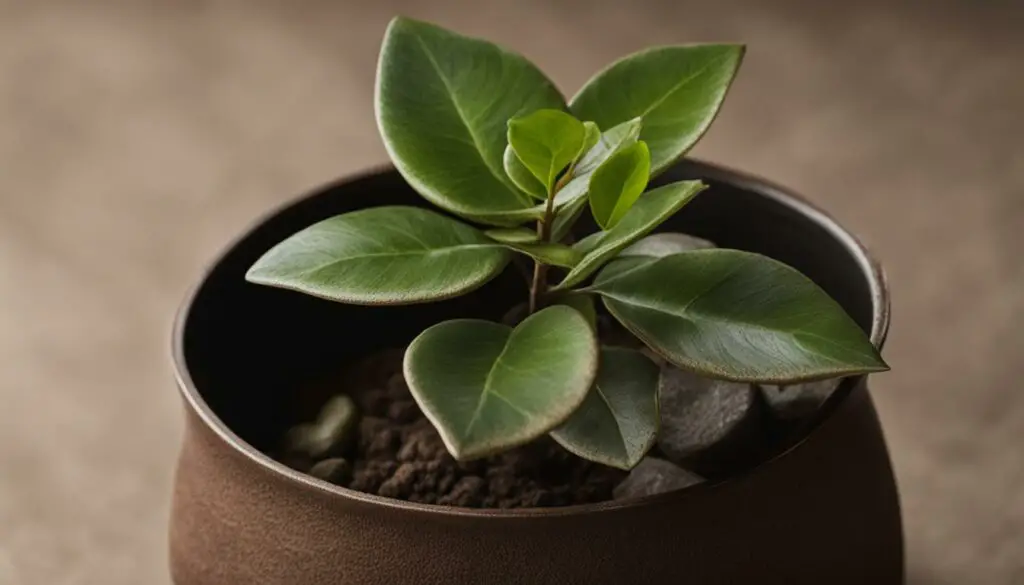
“The earth element provides a sense of grounding and stability to your space. By integrating earthy tones, natural materials, and nurturing objects, you can create a harmonious and balanced home environment.”
Enhancing Energy with the Metal Element in Feng Shui
The metal element in Feng Shui represents clarity, precision, and efficiency. It is commonly associated with the colors white, gray, and silver, as well as circular and spherical shapes. When used thoughtfully, the metal element can enhance the energy flow in your space and promote focus, organization, and productivity.
To incorporate the metal element into your home or office, consider adding metal objects or accents such as:
- Sculptures or figurines made of metal
- Metallic picture frames or mirrors
- Decorative metal bowls or vases
- Stainless steel appliances or fixtures
The placement of metal objects is also crucial for optimal energy flow. Place metal objects in areas where you need increased focus or clarity, such as a workspace or study area. Avoid placing metal objects in areas associated with relaxation and calmness, such as the bedroom.
It’s important to note that you should not overdo the metal element in your space, as an excess of metal can create a cold and unwelcoming atmosphere. Balance is key in Feng Shui, and the metal element should be used in moderation.
Using Metal to Enhance Your Career Area
The metal element is particularly beneficial when used in the Career area of your home or office. The Career area is located in the front center of your space and represents your professional aspirations and growth.
To enhance the energy flow in your Career area, consider adding metal objects such as:
| Metal Object | Significance |
|---|---|
| Desktop organizer | Represents organization and efficiency |
| Metallic picture frame with an image of your career aspirations | Helps motivate and inspire you towards your goals |
| Decorative metal bowl with coins or gemstones | Symbolizes wealth and prosperity |
By incorporating the metal element into your Career area, you can promote clarity, focus, and success in your professional endeavors.
Remember that Feng Shui is all about balance and intention. Thoughtfully incorporating the metal element into your space can enhance the energy flow and bring positive changes to your life. Experiment with different metal objects and placement to find what works best for you.
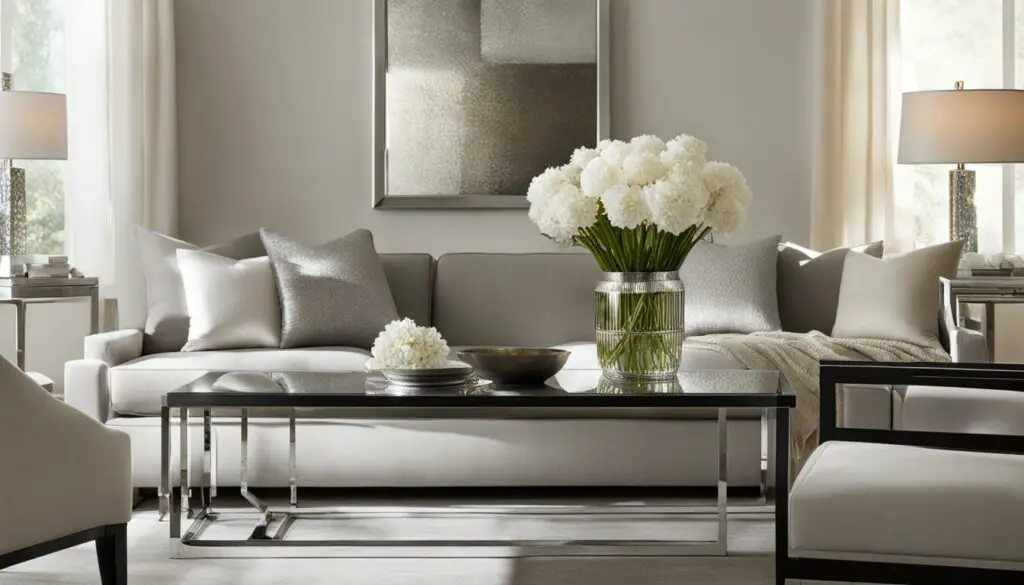
Utilizing the Water Element in Feng Shui
The water element is a powerful tool for promoting relaxation and calmness in your space. It represents abundance, flow, and purification, making it an ideal addition to any home. By incorporating water features, colors, and symbols into your environment, you can create a tranquil and rejuvenating atmosphere.
When using water in Feng Shui, it’s essential to ensure the water is clean and flowing. Stagnant or dirty water can have negative effects and bring unwanted energy into your space. Consider adding a small fountain, aquarium, or water feature to your home to promote beneficial energy flow.
Water Element Colors
The colors associated with the water element in Feng Shui include blue and black. These colors can be used in your home decor, such as through textiles, artwork, or accent pieces, to bring in the soothing energy of water.

Water Element Symbols
Symbolic representations of water can also be used to enhance the water element’s energy in your space. Consider incorporating images of oceans, rivers, or other bodies of water into your decor. You can also use mirrors to represent water and promote the flow of energy.
Placement of Water Element
The placement of water features in your space can also impact the water element’s energy. Consider placing a small fountain in the wealth corner of your home (located in the southeast) to promote abundance and prosperity. You can also place a water feature in the career corner of your home (located in the north) to enhance your career and life path.
Incorporating the water element into your home through colors, symbols, and features can bring a sense of peace and tranquility to your space. By promoting the flow of energy and purifying your home’s environment, you can enhance your overall well-being and create a harmonious living space.
Embracing the Wood Element in Feng Shui
The wood element in Feng Shui encourages growth, balance, and harmony in your home. By incorporating wood elements, you can connect with nature, promote physical and emotional healing, and create a space that encourages renewal.
The wood element is associated with the color green and represents the energy of the east and southeast areas in Feng Shui. The shape associated with the wood element is columnar or rectangular, while the material is, unsurprisingly, wood.
Using Wood Elements in Your Space
One of the easiest ways to incorporate wood elements in your home is by adding plants. Not only do plants provide a natural touch to your decor, but they also help purify the air and create a calming atmosphere. Choose plants that are suitable for your home’s lighting conditions and care abilities. A fiddle-leaf fig or a rubber plant can be a great addition to your home’s wood element.
You can also incorporate wood elements by choosing wooden furniture, such as bookshelves or a coffee table. The wood element is also enhanced with shapes that represent columns, such as tall and slender vases or floor lamps.
When incorporating wood elements, it’s essential to choose items that are in good condition, with no cracks or damage, and well-maintained. This can ensure that positive energy flows smoothly throughout your home.
Optimal Placement of Wood Elements
The optimal placement of wood elements depends on the Bagua map and the specific room, but generally, the east and southeast areas of your home are excellent for incorporating wood elements. You can add plants or wooden furniture to these areas to enhance the wood element’s energy.
Avoid placing wood elements in the south or southwest areas of your home, as these areas are associated with the fire and earth elements. Too much wood in these areas can create an imbalance and negative energy flow.
The Benefits of Incorporating Wood Elements
Incorporating wood elements in your home can bring numerous benefits to your overall well-being. The wood element is associated with growth, vitality, and health. By incorporating wooden furniture and plants, you can create a connection with nature and promote physical and emotional healing. Research suggests that plants can help reduce stress, lower blood pressure, and improve overall mood.
In addition, adding wood elements to your home can promote creativity and productivity. The energy of the wood element encourages growth and renewal, making it an excellent addition to your workspace or study area.

Embrace the wood element in Feng Shui to enhance your connection with nature, promote healing, and create a harmonious, balanced home environment.
Balancing the Five Elements in Feng Shui
Incorporating the five elements in Feng Shui is more than just placing objects around the room. Achieving a harmonious balance of the five elements is essential to create positive energy flow and enhance your overall well-being. Here are some tips to help you balance the five elements:
Assess the Elemental Composition of Your Space
The first step in balancing the five elements is to assess the current elemental composition of your space. Take note of the dominant elements and their corresponding areas. For example, if you have a lot of fire elements in your living room, you may want to balance it out with water and metal elements.
Use the Productive and Reductive Cycles
The productive and reductive cycles are two of the fundamental principles in Feng Shui that can help you balance the five elements in your space. The productive cycle refers to the natural order of the elements, where one element feeds another. For example, wood feeds fire, fire produces earth, earth produces metal, metal holds water, and water nourishes wood. The reductive cycle refers to the natural order of the elements, where one element controls another. For instance, wood controls earth, earth controls water, water controls fire, fire controls metal, and metal controls wood.
By using these cycles, you can balance the elements in your space and create a harmonious flow of energy. For instance, if you have too much wood in a room, you can balance it out by introducing metal elements that control wood.
Use Colors to Balance the Elements
Colors play a significant role in balancing the five elements in Feng Shui. Each element has a corresponding color that can help enhance its energy. For example, the fire element is associated with red, orange, and yellow colors, while the water element is associated with black and blue colors.
By incorporating the right colors in your space, you can balance the elements and create a more harmonious environment. For instance, if you have too much fire element in a room, you can balance it out by introducing more water element colors like blue or black.
Use Objects to Balance the Elements
Objects can also help balance the five elements in your space. Each element has corresponding objects that can enhance its energy. For example, the fire element is associated with triangular shapes, candles, and bright lights, while the earth element is associated with square shapes, ceramics, and pottery.
By incorporating the right objects in your space, you can balance the elements and create a more harmonious environment. For instance, if you have too much metal elements in a room, you can balance it out by introducing more earth element objects like ceramics or pottery.

When done correctly, balancing the five elements in your space can create a supportive and nurturing environment that promotes positive energy flow and enhances your well-being. By assessing the elemental composition of your space, using the productive and reductive cycles, incorporating the right colors and objects, you can achieve a harmonious balance of the five elements in your space.
Enhancing Specific Areas with the Five Elements in Feng Shui
The five elements in Feng Shui can be used to enhance specific areas of your home or office, creating a supportive and harmonious environment.
Bedroom
The bedroom is a crucial area for rest and relaxation. Incorporate the water element to promote a sense of calmness and tranquility. Add a small fountain, a piece of art featuring water, or use blue or black colors to represent water. The wood element can also be introduced to the bedroom to promote a sense of renewal and growth. Place a plant or some wooden furniture, and use green colors for the walls or bedding to represent the wood element. Avoid using the fire element in the bedroom, as it can create restlessness and disrupt sleep.
Living Room
The living room is a social hub for family and friends. Enhance the energy flow in this area by incorporating the fire element to create warmth and vitality. Use red or orange colors, candles, or a fireplace to represent fire. The wood element can also be introduced to create a sense of growth and harmony. Place a plant, use green colors, or incorporate wooden furniture to represent the wood element.
Workspace
The workspace requires focus, productivity, and efficiency. Enhance these qualities by incorporating the metal element to promote clarity and precision. Use metallic colors such as silver or gold and add metal objects such as a desk lamp or a metal sculpture. The earth element can also be introduced to promote stability and grounding. Use earthy colors such as tan or beige, and add earthy objects such as a clay pot or a landscape photo to represent the earth element.

“Incorporate the water element to promote a sense of calmness and tranquility.”
By incorporating the appropriate elements into specific areas of your home, you can enhance the energy flow and create a supportive and harmonious environment. Remember to balance the elements according to the principles of Feng Shui, and to choose colors, materials, and objects that resonate with your personal style and taste.
Feng Shui Colors for Each Element
The use of colors is an essential aspect of Feng Shui, as each color corresponds to a specific element, and incorporating them into your environment can enhance the energy flow in the space. Here’s a breakdown of the colors associated with each of the five elements in Feng Shui:
| Element | Color |
|---|---|
| Fire | Red, orange, yellow, purple, pink |
| Earth | Light yellow, beige, light brown |
| Metal | White, gray, silver, gold, metallic |
| Water | Black, dark blue |
| Wood | Green, brown |
When selecting colors for a particular room, consider the intended purpose of the space and the elements that would best support that function. For example:
- For a bedroom, consider incorporating earthy tones or colors that evoke tranquility, such as light blue or green, to promote restful sleep.
- In a workspace, opt for metal colors such as white or gray to increase focus and productivity.
- To enhance the energy flow in the living room, incorporate wood elements and colors such as green or brown to promote relaxation and harmony.
Remember, the colors should complement the overall energy flow in the space and work in harmony with the other elements present. Don’t be afraid to experiment and find what works best for you and your environment.

The Power of Symbols and Decorative Objects in Feng Shui
In Feng Shui, symbols and decorative objects are essential tools for enhancing the energy flow in your space. They can positively influence the environment and create a sense of harmony and balance in your home.
Symbols such as the dragon, tortoise, and phoenix are significant in Feng Shui and represent particular elements and their qualities. The dragon is associated with the fire element, while the tortoise symbolizes stability and represents the earth element. The phoenix represents rebirth and renewal and is associated with the wood element.
Decorative objects, such as crystals, mirrors, and wind chimes, can also be used in Feng Shui to enhance energy flow. Crystals, especially the clear quartz, are known for their healing properties and can balance energy in your space. Mirrors can expand space and reflect positive energy, while wind chimes can create a soothing and calming atmosphere.
The Dragon Symbol
The dragon is a symbol of power and energy in Feng Shui. Use the dragon symbol in areas where you need a boost of energy or motivation, such as the workspace. Ensure that the placement of the dragon is appropriate and aligns with the fire element’s energy. Use colors such as red, orange, or purple, which are associated with the fire element, to enhance the energy flow.
Crystals in Feng Shui
Crystals are powerful tools in Feng Shui and have been used for centuries for their healing properties. Clear quartz, in particular, is known to balance energy and promote positive vibes in your space. Place crystals in areas such as the living room or bedroom to promote relaxation and calmness. Use different colors and shapes of crystals to enhance the energy flow and balance the different elements.
| Crystal | Color | Element |
|---|---|---|
| Amethyst | Purple | Fire |
| Green Aventurine | Green | Wood |
| Carnelian | Orange | Fire |
Wind Chimes in Feng Shui
Wind chimes are another decorative object used in Feng Shui to promote positive energy flow in your space. They create gentle and soothing sounds that can help you relax and feel calm. Use wind chimes in areas such as the balcony or living room to promote positive energy flow. Ensure that the materials used for the wind chimes align with the appropriate element. Metal wind chimes, for example, are associated with the metal element and can be used to promote focus and clarity.
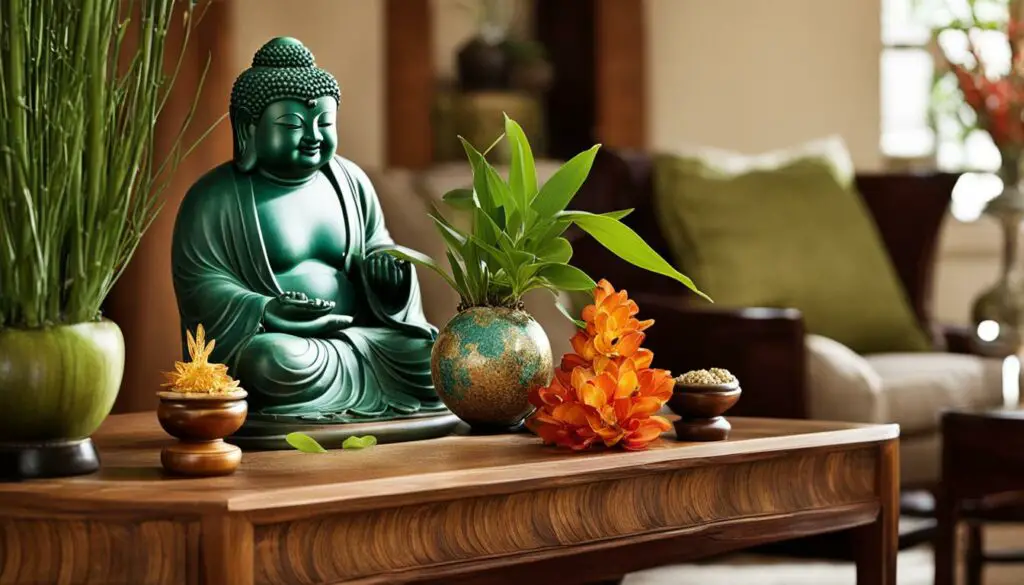
By incorporating symbols and decorative objects into your Feng Shui practice, you can enhance the energy flow in your space and promote balance and harmony. Use the appropriate symbols and materials associated with each element to create a supportive and energetically balanced home environment.
Feng Shui Tips for a Balanced Home
Creating a harmonious and balanced home environment requires more than just incorporating the five elements of Feng Shui. Here are some additional tips to optimize energy flow and promote a sense of well-being:
Declutter Regularly
A cluttered space not only looks chaotic but can also disrupt the flow of energy. Make decluttering a regular practice to remove stagnant energy and create space for new opportunities. Keep only what you need and use, and donate or dispose of the rest.
Organize Mindfully
Organization is essential to balance and harmony. Mindfully arrange furniture and items to promote ease of movement and clear pathways. Use storage solutions that are both functional and aesthetically pleasing to maintain a clean and organized space.
Balance Light and Dark
Light and dark colors create a sense of balance in a space. Avoid using too much of either to maintain a harmonious environment. Consider using warmer tones for areas of relaxation and cooler tones for areas of productivity.
Bring the Outdoors In
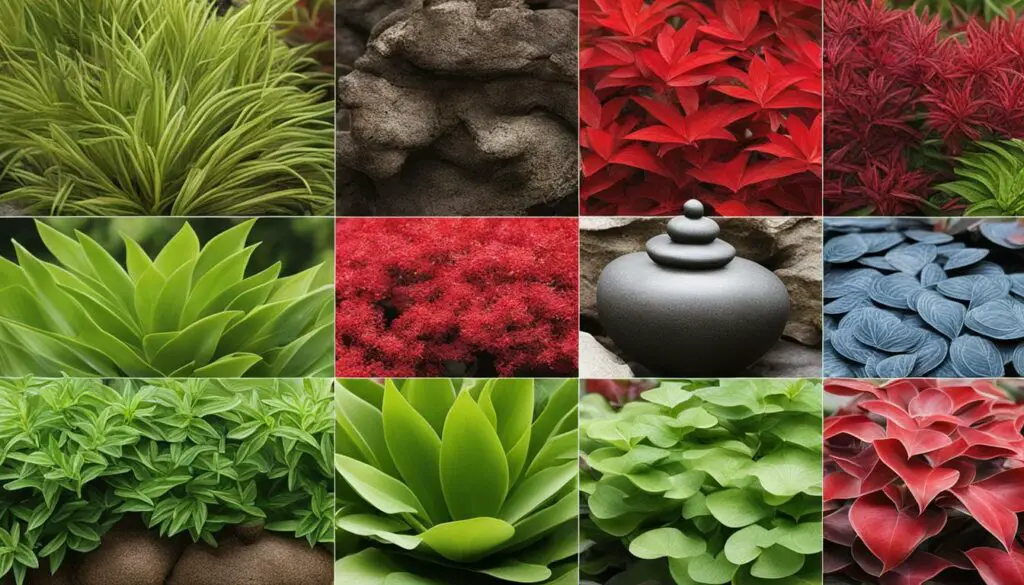
Plants bring life force energy and fresh oxygen into your home. Incorporate plants throughout your space to create a connection with nature, improve air quality, and promote a sense of renewal and growth.
Use Mirrors Wisely
Mirrors reflect light and energy, so be mindful of their placement to ensure positive energy flow. Avoid placing mirrors facing a door or bed, as this can disrupt energy and cause restlessness.
Cleanse Regularly
Cleansing your space regularly can remove negative energy and promote positive vibrations. Use sage, crystals, or sound therapy to purify your space and enhance your connection with the environment.
By incorporating these tips alongside the five elements, you can create a supportive and nurturing space that promotes overall balance and well-being.
The Benefits of Using the Five Elements in Feng Shui
Using the five elements in Feng Shui can have transformative effects on your physical, emotional, and spiritual well-being. By creating a harmonious and energetically balanced space, you can enhance your overall quality of life. Here are some of the many benefits of incorporating the five elements into your home:
- Increased energy and vitality: By balancing the five elements in your home environment, you can create a space that promotes optimal energy flow. This can result in increased vitality, motivation, and inspiration.
- Improved focus and productivity: Incorporating the metal element in Feng Shui can promote clarity, precision, and efficiency, leading to improved focus and productivity in your work or study space.
- Enhanced relaxation and tranquility: Water elements, such as fountains or aquariums, can create a calming and soothing atmosphere, promoting relaxation and tranquility.
- Increased abundance and prosperity: Feng Shui techniques, such as using the wood element, can promote growth and abundance in your personal and professional life.
- Improved relationships: By creating a balanced and harmonious environment, you can foster positive relationships with family, friends, and loved ones.
- Reduced stress and anxiety: By reducing clutter and incorporating elements that promote calmness and relaxation, you can create a space that reduces stress and anxiety.
These are just some of the many benefits of incorporating the five elements in Feng Shui into your home. By creating a space that promotes positive energy flow and balance, you can enhance your overall well-being and create a supportive environment for personal growth and success.
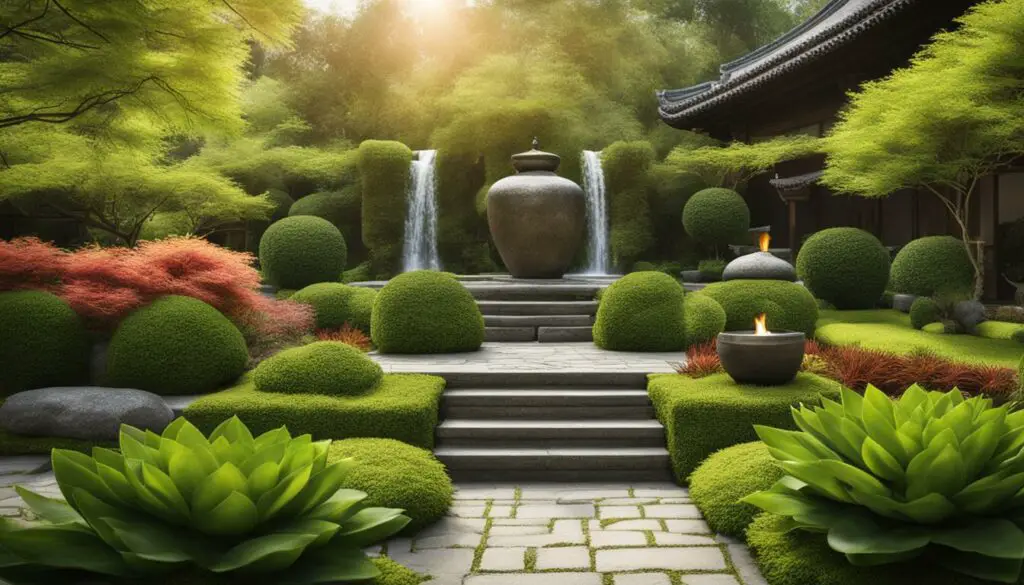
Case Studies: Applying the Five Elements in Feng Shui
Real-life examples can provide insight and inspiration on how to effectively incorporate the five elements in Feng Shui. Let’s take a look at two case studies that demonstrate the transformative effects of incorporating the five elements.
Case Study 1: A Home Office Transformation
One client came to a Feng Shui consultant seeking guidance on how to improve the energy of their home office. The consultant first assessed the space and found that it lacked the water element, which represents flow and abundance. To remedy this, the consultant suggested incorporating a small tabletop fountain, which the client loved. The fountain not only added a water element to the space but also provided a calming ambiance and helped drown out distracting background noise.
The consultant also noticed a lack of the wood element, which represents growth and vitality. They suggested adding a potted plant to the room, which not only added the much-needed wood element but also improved air quality and provided a natural touch to the space.
The result of these changes was a noticeable increase in the client’s productivity and creativity, as well as a more calming and enjoyable workspace.
Case Study 2: A Bedroom Harmonization
Another client sought Feng Shui guidance for their master bedroom, as they often struggled with getting restful sleep. The consultant discovered that the room lacked the earth element, which represents stability and grounding. To remedy this, the consultant suggested adding earthy colors and textures to the space, such as brown and beige throw pillows and a natural fiber area rug. The client also added a large piece of artwork depicting a mountain landscape, which further enhanced the earth element.
The consultant also noticed an excess of the fire element, which represents passion and energy. To balance this, they suggested removing the bright red accent wall and replacing it with a cool blue hue, which added the water element and created a more calming atmosphere.
The result of these changes was a drastic improvement in the client’s sleep quality and an overall feeling of harmony and balance in the bedroom.
These case studies demonstrate the power of the five elements in Feng Shui and how incorporating them thoughtfully can have transformative effects on a space and its occupants.

Conclusion
Incorporating the five elements in Feng Shui can bring about positive changes to your living space and overall well-being. By understanding the characteristics and principles behind each element, you can create a harmonious and balanced home environment.
Remember to take note of the appropriate placement, colors, and shapes associated with each element. This will help you effectively balance the energy flow in your space. Furthermore, consider decluttering and organizing your home to optimize energy flow.
Applying the principles of Feng Shui and the five elements may seem daunting at first, but with practice and patience, you can create a supportive and nurturing space that positively impacts your physical, emotional, and spiritual health.
Start Your Feng Shui Journey Today
Whether you’re looking to enhance your productivity, promote calmness, or increase abundance, Feng Shui and the five elements can help you achieve your goals. Begin by analyzing your space and identifying areas where you can incorporate the five elements. Consult Feng Shui experts or resources for additional guidance and inspiration, and experiment with what works best for you and your home.
By applying these principles, you can transform your living space into a sanctuary that supports and enhances your overall well-being.
FAQ
How do I incorporate the five elements in Feng Shui?
To incorporate the five elements in Feng Shui, you can use specific colors, materials, and objects associated with each element. For example, using fiery colors and triangular shapes for the fire element, earthy tones and square shapes for the earth element, and so on. By strategically placing these elements in your space, you can promote balance and positive energy flow.
What are the five elements in Feng Shui?
The five elements in Feng Shui are fire, earth, metal, water, and wood. Each element has its own qualities and significance in balancing energy. Understanding the principles behind each element can help you create a harmonious environment.
How can I use the fire element in Feng Shui?
The fire element in Feng Shui represents passion and transformation. You can incorporate the fire element by using warm colors like red and orange, placing candles or a fireplace in your space, and using triangular shapes. These elements symbolize energy and can bring vibrancy and inspiration to your environment.
What does the earth element represent in Feng Shui?
The earth element in Feng Shui represents stability and grounding. To incorporate the earth element, you can use earthy colors like brown and beige, add earth-related objects such as pottery or crystals, and use square shapes. These elements can create a sense of security and balance in your home.
How can I enhance energy with the metal element in Feng Shui?
The metal element in Feng Shui signifies clarity and efficiency. To enhance energy with the metal element, you can incorporate metal objects like sculptures or wind chimes, use colors like white and gray, and include round or oval shapes. These elements promote focus, organization, and productivity in your space.
How do I utilize the water element in Feng Shui?
The water element in Feng Shui represents flow and relaxation. To utilize the water element, you can incorporate water features like fountains or aquariums, use colors like blue and black, and include wavy or irregular shapes. These elements can create a sense of calmness and tranquility in your environment.
How can I embrace the wood element in Feng Shui?
The wood element in Feng Shui symbolizes growth and harmony. To embrace the wood element, you can incorporate plants or wooden furniture, use green colors, and include rectangular shapes. These elements promote a sense of renewal and connection with nature in your space.
How do I balance the five elements in Feng Shui?
Balancing the five elements in Feng Shui is essential for creating a harmonious environment. You can balance the elements by assessing the elemental composition of your space and making adjustments as needed. For example, if there is an imbalance of fire, you can introduce more water or earth elements to create equilibrium.
How can I enhance specific areas with the five elements in Feng Shui?
Different areas of your home or office can benefit from specific elements in Feng Shui. For example, in the bedroom, you can use soothing water or wood elements to promote relaxation and harmony. In the workspace, incorporating metal elements can enhance focus and productivity. Explore tips and guidelines for each area to create a supportive environment.
What are the Feng Shui colors for each element?
The associated colors for each element in Feng Shui are fire (red, orange, purple), earth (brown, beige, yellow), metal (white, gray, metallic tones), water (blue, black), and wood (green). By incorporating these colors into your space, you can enhance the energy and symbolism of each element.
How can I use symbols and decorative objects in Feng Shui?
Symbols and decorative objects hold great importance in Feng Shui as they can influence the energy of a space. You can use symbols such as the yin yang symbol or the Bagua mirror to ward off negative energy, and decorative objects like crystals or mirrors to enhance positive energy flow. By selecting and placing these objects thoughtfully, you can create a harmonious and energetically supportive environment.
What are some Feng Shui tips for a balanced home?
In addition to incorporating the five elements, there are other Feng Shui tips for creating a balanced home. Decluttering and organizing your space, arranging furniture to optimize energy flow, and using natural light and fresh air are all important practices. By following these tips, you can create a supportive and nurturing environment.
What are the benefits of using the five elements in Feng Shui?
Using the five elements in Feng Shui can have transformative effects on your physical, emotional, and spiritual well-being. By creating a balanced and harmonious environment, you can experience increased harmony, abundance, and overall balance in your life. The elements can also help promote positive energy flow and enhance your overall sense of well-being.
How can I apply the five elements in Feng Shui through case studies?
Case studies provide practical insights into how others have effectively used the five elements in Feng Shui. By studying these examples, you can gain inspiration and learn from successful implementations. Explore real-life experiences of applying the principles of Feng Shui and the five elements to create energetically balanced spaces.

